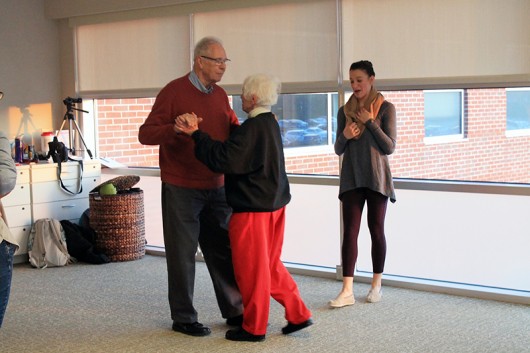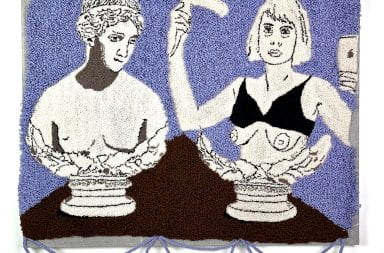Two students at Ohio State hope to heal and express stories of survival through an unexpected medium: dance.
Serena Chang and Mimi Lamantia have been selected as the first dancers to receive the Pelotonia Fellowship in April.
The Pelotonia Undergraduate Fellowship Program, according to its website, was founded in 2010 and provides one-year fellowships to OSU undergraduates who are interested in exploring multidisciplinary approaches to support the cancer community. Lamantia and Chang, both lifelong dancers with medical backgrounds, were awarded $12,000 as 2015 Pelotonia Undergraduate Fellows to use dance as their approach while they pursue very different goals in cancer research.
Chang, a fifth-year in dance and molecular genetics, is creating a contemporary dance piece about the cancer community with four people diagnosed with cancer and nine student dancers, which she hopes will allow audiences to understand the relationship between the cancer community and the world around it.
“My piece is not describing three cancer survivors and patients’ experiences, but it’s more about the cancer community,” Chang said. “I don’t feel comfortable trying to emulate what it might feel like because I’ll never know how it really feels like to have cancer, but what we can understand through these people is kind of the relationships, how we as humans help each other to get through things.”
Chang said she wanted to create a dance about cancer because her diverse background in dance and cancer research has shaped her view on arts and medicine, which allows her to recognize the power of arts in addressing a complex and sensitive topic like cancer.
“A lot of times people see cancer as a purely scientific thing, but in fact cancer happens within a person who has a soul, and there are much more complexities than what happens in your cells,” Chang said. “Medicine can only go so far, and it’s the people around you and the relationships you have with them that will also make you feel better. That’s why art is important.”
Susan Hadley, chair of the Department of Dance at OSU who’s also Chang’s choreographic adviser for the project, said Chang’s project is a great example of how art centered around the cancer experience gives a humanistic approach to address this dark topic.
“The potential for the arts to reach out to people who don’t necessarily know much about the art form, but know a lot about the cancer experiences and to watch that interaction is exciting to me,” Hadley said.
The people affected by cancer, according to Chang, while not physically dancing the piece, have been actively involved in the project, sharing their life stories and giving feedback after watching the rehearsals.
Chang said that it has been an extremely inspiring process for both parties. Chang and her fellows get to learn how important it is to be present in life after learning cancer patients’ life stories, while cancer patients and survivors view the process of co-creating the piece as an emotional relief.
On Nov. 12, Jessica Wilt, one of the cancer patients in Chang’s project, passed away after fighting Ewing’s sarcoma, a rare type of cancer, for 18 months, leaving Chang and other dancers in great sorrow.
“There are so many parts of our piece that Jessica is so present in still. I never go to the studio without thinking about her, she’s definitely still part of my project,” Chang said.

Mimi Lamantia, a fifth-year in dance, holds Argentine tango classes for cancer survivors and their caregivers, aiming to improve the balance and life quality of people who had cancers. Credit: Shiyun Wang | Lantern Reporter
Unlike Chang, who is trying to interpret and display cancer experiences through performing dance, Lamantia, a fifth-year in dance who wants to go to medical school after graduation, has been working on a dance-based intervention project, aiming to improve cancer survivors’ balance and moving ability by teaching the cancer patients Argentine tango.
“Argentine tango was used in (remedying) Parkinson disease and it was validated to improve balance,” Lamantia said. “Similar balance and walking deficits have been experienced in some cancer survivors, typically post-chemo, because of what’s called chemotherapy-induced peripheral neuropathy. So we wanted to see if this dance form can also be used in cancer community.”
Lamantia’s Argentine tango classes are held at Stefanie Spielman Comprehensive Breast Center twice a week, according to Lamantia. A complete class session contains 20 two-hour classes, during which cancer survivors and their caregivers learn and practice Argentine tango under the guidance of Lamantia and volunteers of the project.
Besides teaching Argentine tango, Lamantia said she also collects data from the cancer survivors who participate in the project to see whether tango really has improved their balance.
“I really love tango classes,” said Bobbie Mucha, who was diagnosed with cancer in 2013 and has been taking tango classes with her husband since October. “Tango is very complex and takes a lot of coordination. I like the complexity of it. It’s a challenge that is fun.”
Mucha also said that although she hasn’t see any visible improvements in her balance, she has the confidence that for her and her husband, Argentine tango is the right thing to do and will benefit them eventually.
Another part of Lamantia’s research is to look at her teaching methods as a dance teacher, she said.
“I have taken a lot of pedagogy classes like how to teach dance to different people or how to articulate a movement,” Lamantia said. “It’s really fun to plan the classes and to witness the improvement of the dancers in my classes from week one to week 10.”
Now holding the second session of her Argentine tango classes, Lamantia said she was amazed by the strong community formed with her students and volunteers, which makes the tango classroom not only a place for dancing, but a safe place where people can open up to one another and talk about everything from tango to cancer.
“I’ve been working really hard on the research end of it and I would love the numbers to come out to prove that tango can do something great for cancer survivors,” Lamantia said. “But even if none of the numbers come out, I know that I’ve impacted people’s lives just by allowing them to dance with their loved ones. That’s all I really want at the end of the day.”


